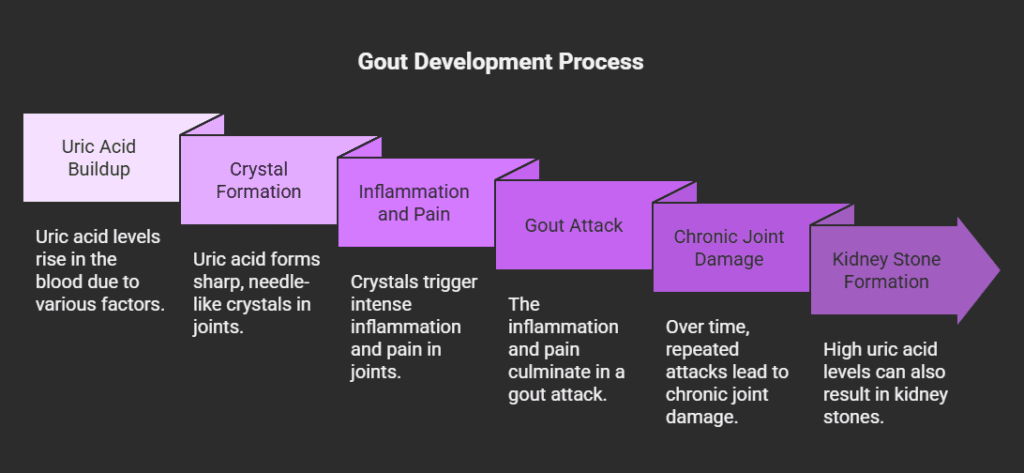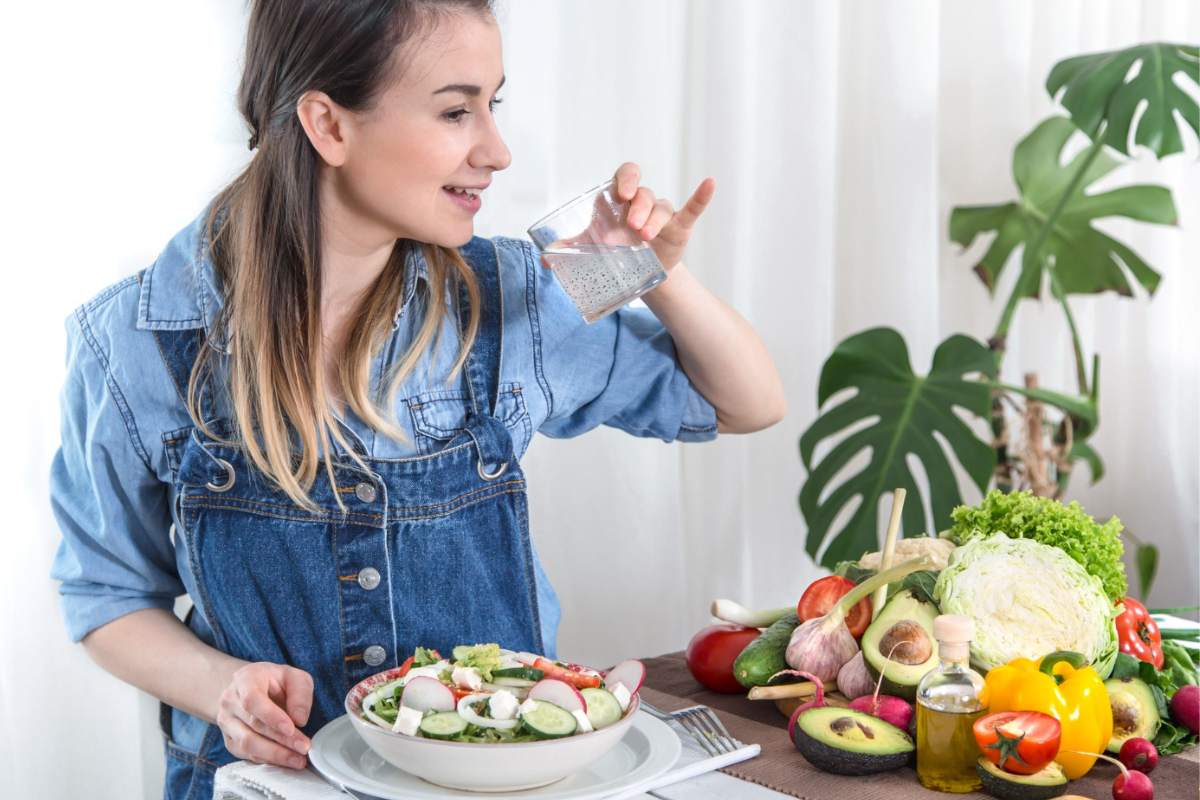So, the doctor dropped the “uric acid” bomb.
Maybe it was during a routine check-up, the numbers coming back just a little…off. Or maybe you know the story all too well, waking up to a throbbing, angry, ca n’t-even-stand-the-weight-of-a-bedsheet-on-it big toe. A pain so exquisite, so fiery, you wouldn’t wish it on your worst enemy. That, my friend, is the calling card of gout, uric acid’s most famous, and most painful, complication.
Whatever the reason, you’re here. You’ve been told to watch your levels, and the first place you’re meant to look is your plate. And if you’re feeling a bit overwhelmed, maybe even a little resentful about having to give up some of your favorite foods? Take a deep breath. You’re in the right place.
Because this isn’t just another sterile, boring list of “eat this, not that.” Far from it. This is a real conversation about food, about lifestyle, and about taking back control. It’s a guide for living well, not just for avoiding a flare-up. We’re going to get into the nitty-gritty, the whys and the hows, and we’re going to do it without making you feel like you’re staring down the barrel of a life sentence of bland, joyless meals.
Believe it or not, managing your uric acid can be… empowering. It’s a chance to get in tune with your body, to understand what makes it tick and what makes it mad. Ready to get started? Let’s dive in.
What’s the Big Deal with Uric Acid, Anyway?
Before we start ransacking your pantry, let’s get one thing straight. Uric acid isn’t some evil villain. It’s a normal, naturally occurring substance in your blood. Your body produces it when it breaks down chemicals called purines.
Think of it like this: your body is a busy workshop, constantly building and repairing. Purines are like the raw materials, the sawdust and leftover scraps from all that work. Your kidneys are the cleanup crew, filtering this “sawdust” (uric acid) out of your blood and sending it out of your body via your urine. It’s a pretty slick system, most of the time.
The problem starts when the system gets out of whack.

Either your body starts producing way too much sawdust, maybe you’re feeding it a ton of purine-rich materials, or your cleanup crew (the kidneys) gets a bit sluggish and can’t sweep it all away efficiently. When that happens, the uric acid builds up in your blood. It has nowhere to go. So it travels around your body, looking for a place to settle, and it has a particular fondness for cooler spots, like your joints.
And when will it settle? It forms tiny, sharp, needle-like crystals. Ouch. That’s not a metaphor; that’s literally what’s happening. Those urate crystals are what trigger the intense inflammation and agonizing pain of a gout attack. It’s not just a pain; it’s a fire. A full-on, five-alarm blaze in your joint. And over time, this can lead to not just more frequent attacks, but also chronic joint damage and even kidney stones.
Scary stuff, right? But here’s the kicker: you have way more control over this than you think. And it starts with the fuel you put in your body.
The Game-Changer: Your Plate
When it comes to managing uric acid, your diet is, without a doubt, the single biggest lever you can pull. It’s the game-changer. It’s how you go from being a victim of your symptoms to the master of your well-being.
The core principle is simple: manage your purine intake. Now, this doesn’t mean you have to eliminate every single purine from your life. That’s practically impossible, and frankly, it wouldn’t be healthy. Lots of very nutritious foods contain purines. The key isn’t elimination; it’s strategy. It’s about knowing which foods are packed to the gills with purines and which ones are safe to enjoy freely.
It’s time to know your friends from your foes.
The ‘Green Light’ List: Foods to Embrace and Enjoy
Let’s start with the good news. The great news. The list of foods you can and should be eating is long, vibrant, and delicious. This is about abundance, not deprivation. Get ready to pile your plate high.
Fruits: Nature’s Candy and Your New Best Friend
If there’s one food group to fall head over heels for, this is it. Most fruits are wonderfully low in purines and packed with things that actively help your cause.
- Cherries, Cherries, Cherries! Okay, let’s just get this one out of the way. Cherries are the undisputed heavyweight champion in the fight against uric acid. They are legendary. They contain powerful antioxidants called anthocyanins, the stuff that gives them that gorgeous, deep red color, which have incredible anti-inflammatory properties. Some studies suggest that eating cherries or drinking tart cherry juice can lower uric acid levels and slash the risk of a gout attack. So, yes, believe the hype. A cup a day might just keep the doctor away. Seriously.
- Vitamin C Powerhouses: Your body loves Vitamin C. And you know what else loves it? Your kidneys. Vitamin C has been shown to help the kidneys excrete more uric acid. So, load up! Think oranges, grapefruits, kiwi, and strawberries. A simple orange for a snack? That’s not just a snack; that’s a strategy.
- Apples & Bananas: The humble apple contains malic acid, which is thought to help neutralize uric acid. Bananas are low in purines and a great source of potassium, which helps prevent uric acid from crystallizing. Easy, portable, and effective. What’s not to love?
Vegetables: A Rainbow of Goodness
Now, vegetables can feel like a bit of a minefield because of some old, outdated advice. The truth? Plant-based purines just don’t seem to affect your body in the same way animal-based ones do. So, while some veggies are higher in purines than others, the consensus now is that the benefits of eating a wide variety of vegetables far, far outweigh any potential risk.
- The All-Stars: Cucumbers, bell peppers (all colors!), carrots, broccoli, squash, and potatoes are all low-purine heroes. They are hydrating and full of fiber and vitamins. Roast them, steam them, eat them raw in a giant salad. Go crazy.
- What About Spinach and Asparagus? Ah, the age-old question. Yes, foods like spinach, asparagus, mushrooms, and cauliflower have a moderate amount of purines. For years, they were on the “avoid” list. Funny thing is, recent research has thrown that into question. Studies have failed to show a link between eating these vegetables and an increased risk of gout attacks. So, unless you find they are a personal trigger, there’s no need to banish them. Just don’t eat a whole pound of asparagus in one sitting. Common sense, you know?
Dairy: The Unexpected Secret Weapon
Here’s a fun surprise. Low-fat dairy is not just safe; it’s actively beneficial. Believe it or not, dairy products seem to have a special power; they promote the excretion of uric acid through your urine.
- Milk & Yogurt: A glass of skim milk or a bowl of low-fat yogurt can literally help flush the bad stuff out. We’re talking a measurable effect here. Greek yogurt, in particular, is a fantastic, protein-packed option for breakfast or a snack. Just make sure you’re choosing the low-fat or non-fat versions, as high-fat dairy doesn’t seem to have the same protective effect.
Grains & Starches: Choose Your Carbs Wisely
Carbohydrates are your friend, but the type of carbohydrate matters.
- Go for Whole Grains: Think brown rice, whole wheat bread, quinoa, and oats. These are complex carbohydrates that are good for your overall health, help with satiety, and are generally low in purines.
- Ditch the White Stuff: Highly processed, refined carbohydrates, white bread, white rice, sugary cereals, cakes, cookies, are another story. They can spike insulin levels, which in turn can reduce how much uric acid your kidneys get rid of. It’s a sneaky backdoor effect that many people miss.
Beverages: Hydrate, Hydrate, and Caffeinate?
- Water is Your Superpower: If cherries are the champion, water is the god-tier superpower. You need to drink it. Lots of it. All day. Think of your body as a system of pipes. Water is what flushes those pipes clean, clearing out all the excess uric acid before it has a chance to set up camp in your joints. Aim for at least 8-10 glasses a day, maybe more if you’re exercising or it’s hot out. Carry a bottle with you everywhere. This is non-negotiable.
- Coffee Lovers, Rejoice! Here’s the best news you might hear all day. Multiple large-scale studies have shown that regular coffee consumption is associated with lower uric acid levels. Yes, you read that right. The effect is seen with both regular and decaf coffee, which suggests it’s not just the caffeine but other compounds in the coffee that are helping out. So, that morning cup (or three)? It’s probably helping.
- Green Tea: Not a coffee person? Green tea is another excellent choice, loaded with antioxidants and beneficial compounds.
The ‘Yellow Light’ List: Proceed with Caution
Life is about balance, right? Not everything is a hard yes or a hard no. This is the zone of moderation. These are foods that aren’t necessarily off-limits forever, but you need to be smart about them. It’s about portion size and frequency.
- Lean Meats: We’ll get to the big, bad red meats in a moment, but what about chicken? A small, palm-sized portion of chicken or turkey breast, a couple of times a week, is generally considered okay for most people. The key is lean and small. A giant fried chicken dinner? That’s venturing into the red zone. But a simple grilled chicken salad for lunch is a different story entirely.
- Oatmeal: Oatmeal is fantastic for you, full of soluble fiber. It does have a moderate level of purines, though. Is this a problem? For most people, no. The benefits are too great to ignore. Just don’t make it your only food source. Having a bowl for breakfast is a world away from having it for every meal.
- Lentils and Legumes: Beans, lentils, and peas are a wonderful source of plant-based protein and fiber. They also carry a moderate purine load. Like the controversial veggies, they used to be on the “no” list, but a new school of thought sees them as a much, much safer bet than animal protein. They are a fantastic substitute for red meat.
- Some Fish: This is a tricky one. We know that some seafood is disastrous for uric acid (more on that below). But what about the others? Fish like salmon, while having more purines than, say, a carrot, are also packed with anti-inflammatory omega-3 fatty acids. For many, a small serving of a lower-purine fish like salmon or trout once in a while might be a reasonable trade-off. This is where you have to listen to your body.
The ‘Red Light’ District: Foods to Seriously Avoid
Okay, time for some tough love. Some foods are just, if I’m being honest, purine-delivery systems. They are so high in these compounds that they can send your uric acid levels soaring and trigger a flare-up with shocking speed. These are the foods to either eliminate or save for the rarest of rare, special occasions.
- Organ Meats: This is the absolute top of the list. Liver, kidneys, sweetbreads, pâté. These are purine bombs. No way around it. They are incredibly dense in purines because of their metabolic function in the animal. Sorry, but these have to go. End of story.
- Red Meat: Beef, lamb, pork, and game meats like venison are all very high in purines. This is often the hardest one for people to swallow, but cutting way back on red meat can make a monumental difference. Think of it as a “once in a blue moon” food rather than a weekly staple.
- Certain Seafood: While some fish are on the yellow list, others are squarely in the red. Anchovies, sardines, herring, mussels, scallops, and mackerel are notoriously high in purines. If you see anchovies on a pizza menu, just walk away.
- Alcohol, Especially Beer: Ah, alcohol. This is a double-whammy. Or rather, a triple-whammy.
- Beer is the worst offender. Why? It’s made from brewer’s yeast, which is fantastically high in purines. It directly adds fuel to the fire.
- Alcohol itself speeds up purine production in the liver. So it’s making your body produce more of the bad stuff internally.
- Alcohol dehydrates you and forces your kidneys to work overtime processing the alcohol, which means they do a much worse job of filtering out and excreting uric acid. So, beer delivers purines and makes your body produce more uric acid and making it harder to get rid of it. It’s the perfect storm for a gout attack. Hard liquor is also problematic. Wine, in very strict moderation (like one small glass), seems to be less of a threat, but honestly, the safest bet is to dramatically reduce your intake across the board.
- The Hidden Villain: High-Fructose Corn Syrup (HFCS): This is the one that surprises everyone. It’s the secret enemy. HFCS contains no purines at all, yet it is one of the worst things you can consume for your uric acid levels. Here’s how it works: your body burns through a lot of energy to process fructose, and this process stimulates the production of uric acid like crazy. It revs up the “sawdust” machine in your workshop to a terrifying degree. Where do you find it? Sugary drinks. Sodas, sweetened iced teas, many fruit juices (yes, even the ones that seem healthy!), and countless processed foods and snacks. You must become a label detective. Cutting out sugary beverages is as important, if not more important, than cutting out red meat.
Beyond the Plate: Lifestyle Tweaks That Make a World of Difference
Your diet is the cornerstone, but a few other lifestyle changes can support your efforts and make you feel a whole lot better.
- Weight Management: This is a delicate subject, but it’s crucial. Carrying extra weight puts more strain on your joints, but it also increases your body’s production of uric acid, making it harder for your kidneys to eliminate it. Losing even a small amount of weight, such as 5-10% of your body weight, can have a significant impact on your uric acid levels and the frequency of gout attacks. Frame it not as a punishment, but as an act of kindness to your body. It’s not about looking a certain way; it’s about taking a burden off your system so it can function better.
- Gentle Movement: Regular exercise is fantastic for your overall health, weight management, and stress levels. But you need to be smart. High-impact, joint-jarring exercise can be a bad idea, especially if your joints are already sensitive. Think gently. Walking is amazing. Swimming is even better; it’s zero-impact and works your whole body. Cycling and yoga are also wonderful choices. The key is consistency.
- Stress Less, Seriously: Who doesn’t have stress? But chronic stress can contribute to inflammation throughout your body. Finding ways to manage it can only help. It doesn’t have to be complicated. Five minutes of deep breathing, a short walk in the middle of the day, and listening to some music, these small acts can make a big difference in your overall state of well-being.
You’ve Got This. Really.
I know, this is a lot of information. It can feel like a complete overhaul of your life. But don’t look at it as a mountain you have to climb all at once. Look at it as a single step.
Start small. This week, make one change. Maybe it’s swapping your daily soda for sparkling water with a squeeze of lemon. Maybe it’s adding a big salad to your lunch. Or maybe it’s just committing to carrying a water bottle with you.
This is a journey, not a destination. There will be days you have a slice of pizza. There will be birthday parties with cake. That’s okay. That’s called being human. The goal isn’t perfection; it’s progress. It’s about feeling better, more energetic, and free from the fear of that next sudden, excruciating attack.
You know now. You know the heroes, the cherries, the water, the low-fat yogurt. You know the villains, the beer, the organ meats, the sugary drinks. You are no longer in the dark.
So go on. Go to your kitchen. Look at it not as a minefield, but as a pharmacy. A place of healing. A place of power. Take back your health, one delicious, smart, and satisfying meal at a time. Your body, and especially your joints, will thank you for it. You’ve got this.








